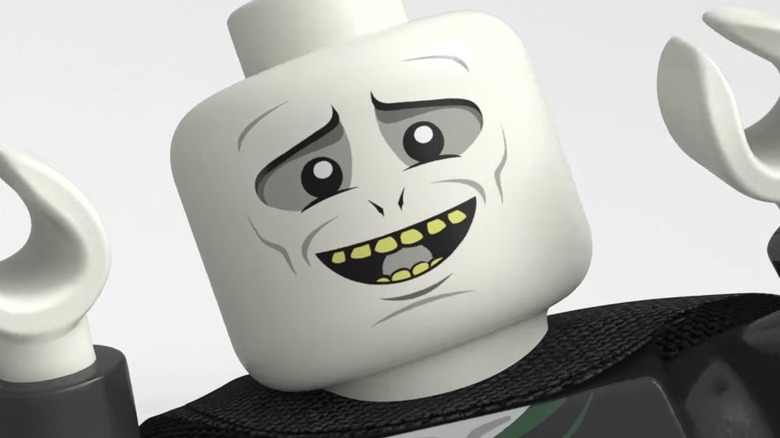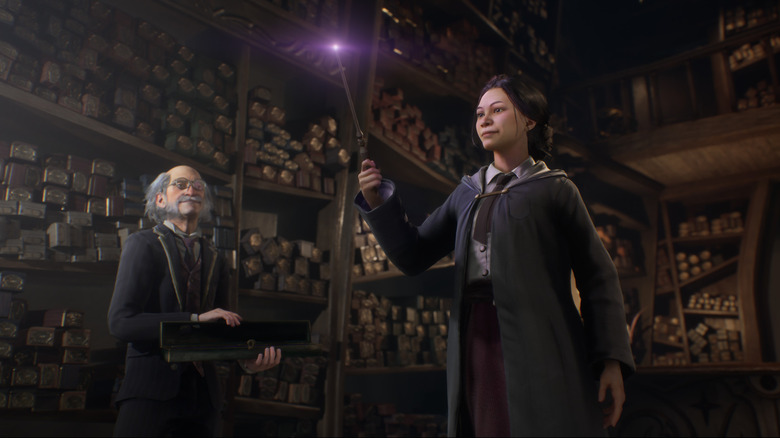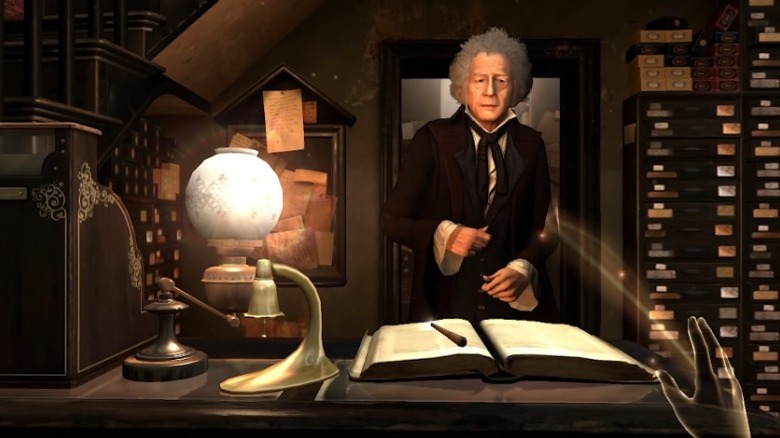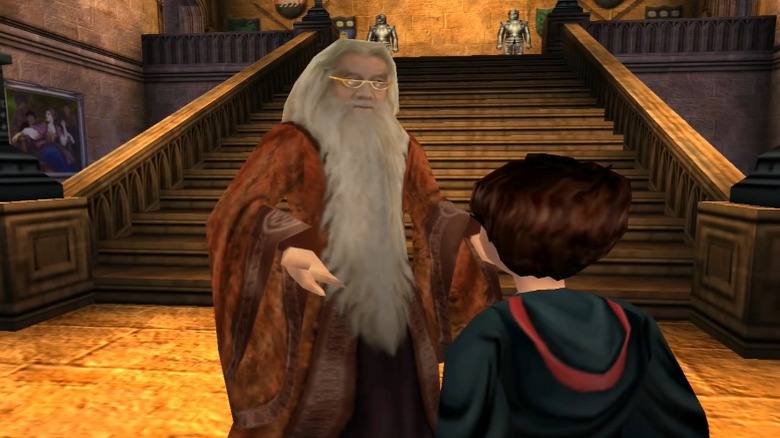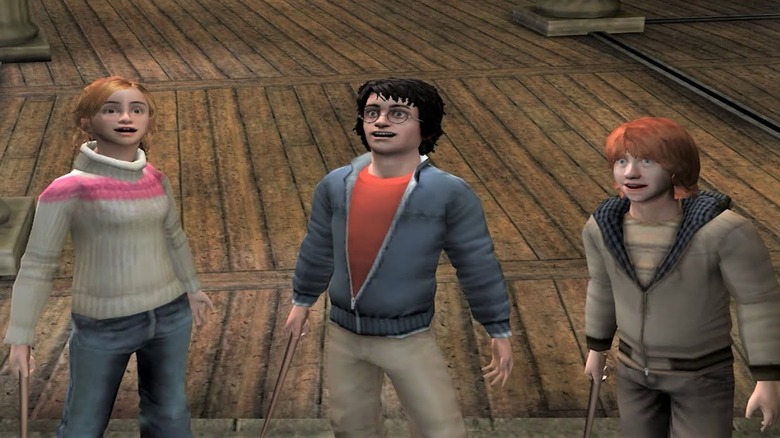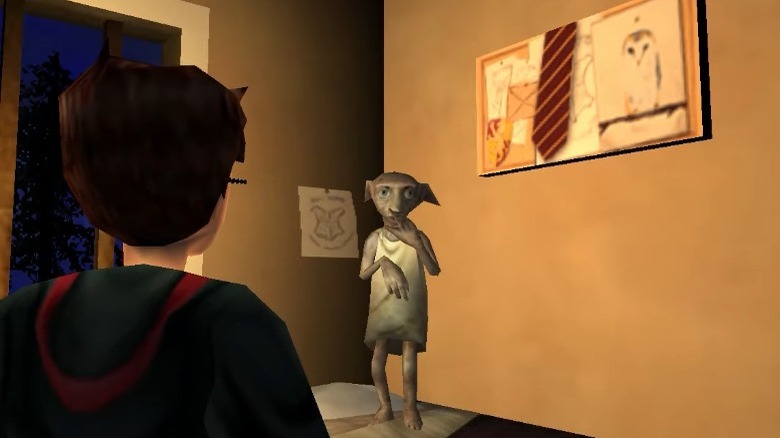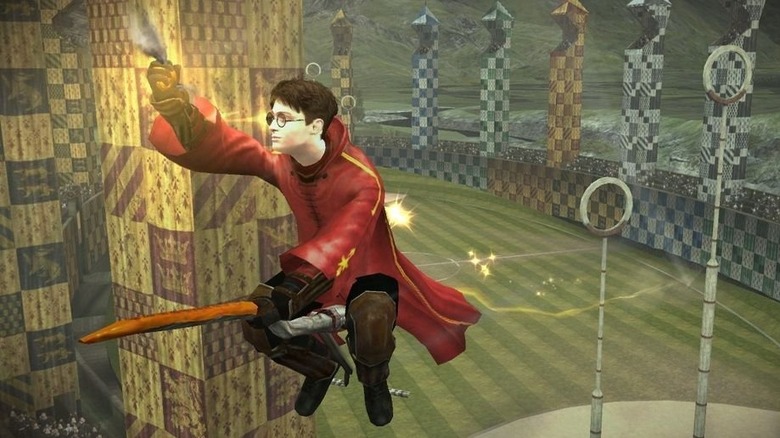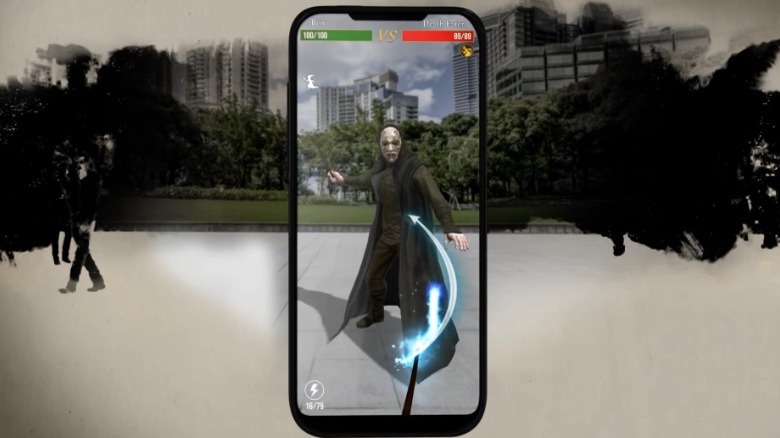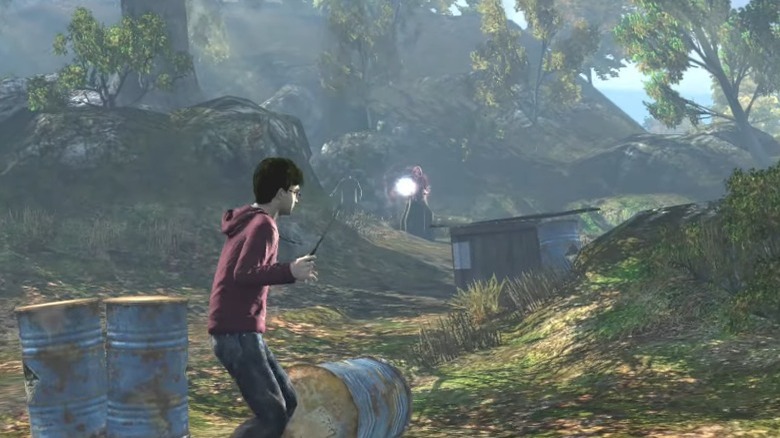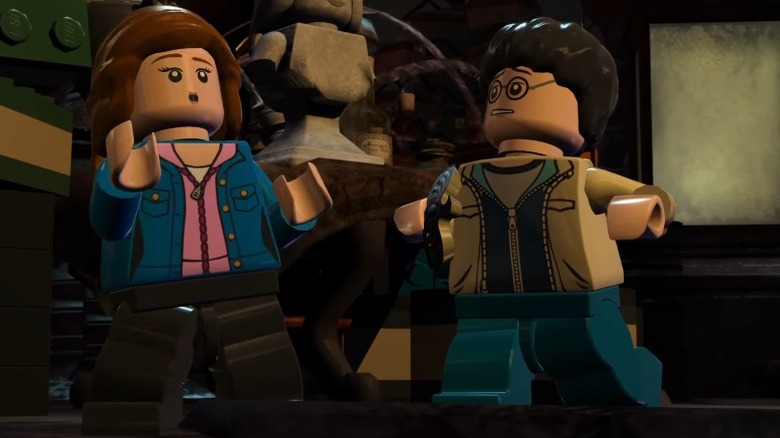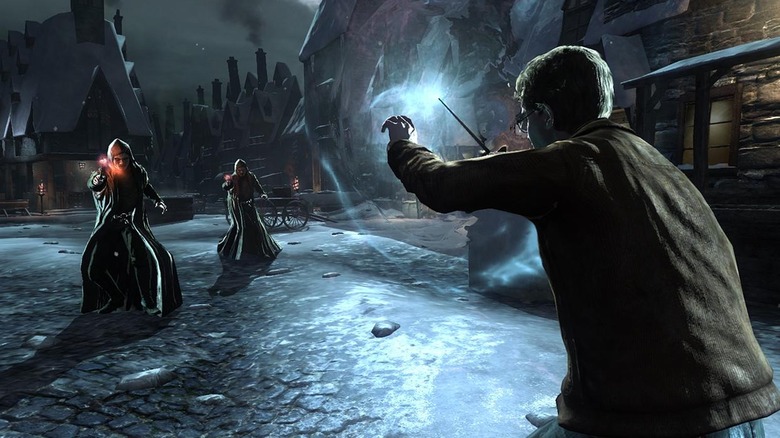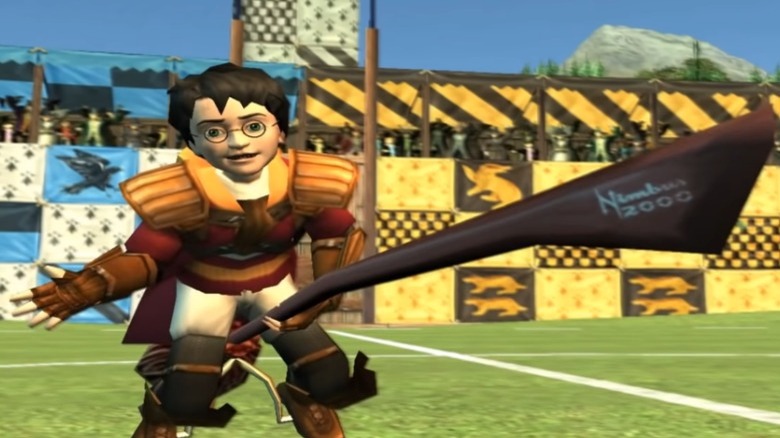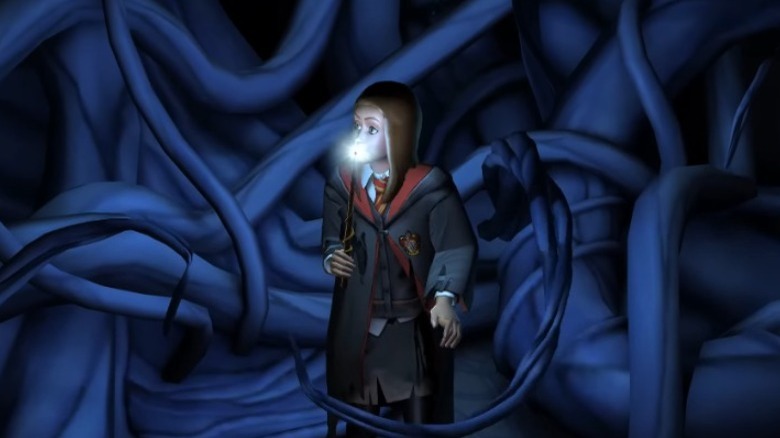6 Magical Harry Potter Games (And 6 That Belong In Azkaban)
Video games based on movies don't always turn out so great. It seems that more often than not, licensed games turn out to be hastily created cash grabs that rope in a handful of movie fans while disappointing gamers everywhere. The "Harry Potter" movies have made billions of dollars at the box office, and so it makes sense that well over a dozen video games have tried to cash in on the franchise as well.
What's miraculous about the "Harry Potter" games isn't that there's so many of them, but that so many of them are actually good. Some games set in the Wizarding World really shine, and the passion that some game developers have for the franchise shines through every puzzle, hidden secret, and high-flying set piece. There are "Harry Potter" games released over two decades ago that are still worth revisiting today, simply because they offer genuinely magical experiences.
On the other hand, more than a few "Harry Potter" games land exactly where you'd expect them to. Some have been sloppily tossed together to line up with a film release, while others are shamelessly attempts to turn a fandom into a lucrative income stream. It's time to suss out which games deserve to win the House Cup — and which ones have earned a one-way ticket to Azkaban.
MAGICAL: Hogwarts Legacy
Some gamers will dismiss "Hogwarts Legacy" out of hand, and it's hard to blame them. There are plenty of reasons to be concerned about the game, from its use of perceived anti-semitic tropes in the plot to "Harry Potter" author J.K. Rowling's history of transphobic comments. The "Harry Potter" brand has been damaged in recent years, and many fans may feel it's easier to stick with nostalgic replays when coming to the franchise at all.
On the other hand, an open-world Hogwarts, a variety of combat-focused spells, and a character creation system that isn't the stuff of nightmares is bound to pull in more than a handful of curious players. "Harry Potter" games have been rolling out for more than twenty years now, so the first thing fans are likely to notice about "Hogwarts Legacy" is that it's the best-looking and most expansive game in the franchise by a mile. Hogwarts and its inhabitants look stunning, and the multicolored spells that start flying during combat are captivating to watch.
Overall, "Hogwarts Legacy" may be underwhelming for gamers who are familiar with open-world experiences, and those people may not really miss out on much by skipping this one. Outside of that, the game makes for a magical-enough experience for fans who've been dreaming of a return to Hogwarts, and it feels like something new for the franchise.
TO AZKABAN: Harry Potter for Kinect
Part of the buzz surrounding "Hogwarts Legacy" was the game's character creation tools, which allows players to fully insert themselves into the Wizard World (along with some fun cosmetics). Real Potterheads know, however, that self-insertion became an option in gaming more than a decade prior. 2012's "Harry Potter for Kinect" opens with a character creation process that really needs to be seen to be believed.
Aside from the option to play the game as a terrifying creature, this Kinect release also came loaded with an impressive amount of disappointing content. Most of what "Harry Potter for Kinect" has to offer are the kinds of minigames that had already worn out their welcome in other "Harry Potter" titles.
Story-wise, the game plays as a greatest hits of Harry's best and worst moments at Hogwarts. Players will get sorted into their house, play some rounds of Quidditch, compete in two of the three Triwizard Tournament events, and defeat Voldemort. Each new scene comes with a simple set of game mechanics that, as is to be expected from the Kinect, boil down to making exaggerated arm gestures or yelling out the names of different spells. The game is exactly as gimmicky as it sounds, just without being much fun to play.
MAGICAL: Harry Potter and the Sorcerer's Stone
Video games based on movies miss the mark often enough, but "Harry Potter and the Sorcerer's Stone" nailed the assignment right out of the gate. What's even more impressive is that it succeeded more than once. The "Sorcerer's Stone" adaptation had an interesting development process that saw five different developers releasing four different versions of the game.
PC and Mac players got to experience an adventure game set in Hogwarts developed by KnowWonder and Aspyr. Players can solve puzzles in the castle, learn new spells in class, and even battle against magical creatures and Voldemort himself. Over on the PlayStation, Argonaut developed a similarly styled third-person adventure game, but handled adapting the movie's story in its own way. Gamers on the go were treated to "Sorcerer's Stone" on the Game Boy Color and the Game Boy Advance. Both versions were developed by Griptonite, but the GBC version offers a "Final Fantasy"-esque roleplaying experience while the Advance tells the story as a top-down action and puzzle game.
Two years after those versions of the game debuted, Warthog Games released a "Sorcerer's Stone" game for the GameCube, PlayStation 2, and Xbox. This "Sorcerer's Stone" had plenty of chances to get things right, and even though none of these turned into an all-time classic, every version of the game packed enough charm and engaging gameplay to remain memorable.
TO AZKABAN: Harry Potter and the Goblet of Fire
The "Goblet of Fire" video game didn't arrive in quite as many variations as previous entries to the series. One version existed on computers and consoles, and a second version made its way to the Game Boy Advance. Both were developed by EA UK, and both managed to massively disappoint fans of the series.
Rather than re-opening the doors of Hogwarts and letting players once again wander its magical halls, "Harry Potter and the Goblet of Fire" is broken into eleven or twelve discrete levels (depending on the version) that are accessed through Dumbledore's Pensieve. Though the levels do have some collectibles and secrets to discover, they mostly play out as on-the-rails action scenes that offer little variety in terms of gameplay.
One potentially promising innovation in "The Goblet of Fire" ended up turning into the game's biggest misfire. For the first time in the series, players could dive into a multiplayer mode that would let Harry, Ron, and Hermione take on many of the game's challenges together. Unfortunately, when friends weren't available to take control of the other characters, players had to contend with a terrible AI piloting their companions. That source of frustration, combined with the game's restrictive level system, makes "The Goblet of Fire" a disappointment.
MAGICAL: Harry Potter and the Chamber of Secrets
If it ain't broke, don't fix it. "Harry Potter and the Chamber of Secrets" followed almost the exact same approach as its console predecessor, just a little bigger and a little better. Once again, different studios stepped in to create alternate versions of the game for various systems, and many of the studios from "Sorcerer's Stone" returned.
KnowWonder and Aspyr once again handled the PC game and Mac port, respectively. Anyone who enjoyed their Hogwarts adventure the first time around found a more polished and perfected game with the same basic ideas in "Chamber of Secrets." Argonaut created a similar adventure game for the PlayStation, but EA UK and Eurcom stepped in to design games for current gen consoles like the PlayStation 2 and Xbox.
Over on the handheld side of things, Gryptonite came back to create a "Chamber of Secrets" game for the Game Boy Color and Advance, which follows the same formula as "Sorcerer's Stone." The GBC game is another classic RPG with turn-based combat, and the Advance game is an expanded version of the puzzle-focused dungeon crawler that Gryptonite had created before. No one reinvented the wheel with "Chamber of Secrets," but they really didn't need to for these games to be great to sell like hotcakes.
TO AZKABAN: Harry Potter and the Half-Blood Prince
A decade after "Chamber of Secrets" showed how developers could improve upon the initial "Harry Potter" video game formula, "The Half-Blood Prince" gave gamers a great example of what happens when a series stagnates. To be fair to this game, its movie counterpart isn't the most exciting entry in the "Harry Potter" franchise either, but the standard for games based on these movies had long been set by 2009.
The main problem with the "Half-Blood Prince" game is that there's very little to actually do in it. Players are once again tossed into a fairly impressive recreation of Hogwarts, but aside from some pointless collectibles, there's very little to find in the castle. Most of the gameplay boils down to a batch of repetitive minigames. There's a half-hearted set of mechanics for playing Quidditch, an almost interesting potion-making challenge, and a nearly entertaining dueling system. Everything's aggressively middling.
Outside of repeatedly playing through those segments or re-experiencing the movie's main plot, players will struggle to keep themselves busy during Harry's sixth year at Hogwarts. Sadly, the game isn't even bad enough to be memorable. It's just an inoffensive, mostly forgettable experience that feels like it was created out of necessity rather than any legitimate passion.
MAGICAL: Wizards Unite
Niantic took the entire world by storm when it released "Pokémon Go" in 2016, and the company was poised to do it all over again in 2019. "Harry Potter: Wizards Unite" combined the gameplay formula from Niantic's previous smash hit with the allure of a Wizarding World story set after "The Deathly Hallows Part 2."
"Wizards Unite" had a brief but glorious run from June 2019 to January 2022. After creating a character, selecting a house, and picking out a wand, players were sent to explore their neighborhoods. While out and about they would discover cursed items and creatures that required some magical problem-solving before they could be collected. Various wizard-friendly inns provided players with more spell energy and the occasional greenhouse kept them in a steady supply of potion ingredients.
The story of "Wizards Unite" was threadbare at best, but Niantic seemed genuinely invested in giving "Harry Potter" fans a great experience. When COVID-19 lockdowns affected people's ability to go outside, the developer added the Knight Bus to the game, which took players to fortresses all around the world where they could battle creatures together. "Wizards Unite" was far from a perfect game, but it gave its most dedicated players some truly magical memories.
TO AZKABAN: Harry Potter and the Deathly Hallows Part 1
Good or bad, just about every "Harry Potter" game leans on the location of Hogwarts as a way to provide players with a sense of structure. Classes and school events propel most of the plots forward, and the castle grounds hide secrets around every corner. Maybe the absence of that familiar safety blanket made the developers at EA panic, or maybe developers were just getting tired of putting fairly formulaic "Harry Potter" video games. Whatever the reason was, EA made the final two "Harry Potter" movie games into third-person cover shooters.
That last sentence doesn't make any more sense now than it did in the lead-up to the "Deathly Hallows" games being released, but fit's safe to say that EA's change in formula was a misstep. The movie version of "Deathly Hallows Part 1" was lighter on action than previous films, and that's a definite problem for this brand of video game adaptation.
The game more-or-less railroads players through the events of the movie, occasionally finding some extra reasons for Harry to duck around walls or trees while blasting spells at his enemies. It's not that the shooting mechanics are awful, just that they're wildly out of place in this half of the story. The magic, wonder, and sense of adventure seen in previous games is sorely lacking here, making "Deathly Hallows Part 1" one "Harry Potter" game that fans should definitely avoid.
MAGICAL: LEGO Harry Potter
"LEGO Harry Potter" takes all the magic and charm of the Wizarding World and shrinks it down to a brick-sized experience that gamers of any age can enjoy. Harry's story was originally adapted for the LEGO-verse in two separate games, but these days, years 1-7 are available in a single collection.
This isn't the place to look for a detailed recreation of the "Harry Potter" storyline, of course, but the game pulls off an impressive amount of storytelling with simple cutscenes and zero dialogue. The real star of the show, once again, is Hogwarts. The school grounds are filled with activities and puzzles to solve. Even after the main plot has been finished, gamers can spend several more hours searching for every last secret and LEGO collectible. The amount of side content available here puts all other "Harry Potter" games to shame.
What makes "LEGO Harry Potter" even better is that you don't have to play it alone. A split-screen mode lets players enjoy some couch co-op with well over a hundred playable characters, plus some customizable LEGO minifigs. Given how LEGO-centric it is, the game won't appeal to everyone. Still, it's without a doubt one of the best "Harry Potter" games ever made.
TO AZKABAN: Harry Potter and the Deathly Hallows Part 2
"Deathly Hallows Part 2" continued a handful of poor decisions that were made with the previous game. The adventure game feel that ran through most other mainline entries in the series has been replaced by third-person cover shooting. Harry must hide behind debris, arm himself with a trusty spell, and shoot magical beams of light at every Death Eater he encounters, kind of like a wizard edition of "Call of Duty." There are multiple spells to unlock, but even though they have slightly different effects, they generally all end up feeling like guns that take down enemies with a few shots.
While trudging through one combat counter after another, the plot unfolds through a collection of on-the-rails levels. Each one contains few surprises other than some truly meaningless collectibles, like "unlockable" characters that can't actually be played. Ultimately the game's competent shooting mechanics aren't enough to save it. For turning the Battle of Hogwarts into a complete bore, this game deserves as small a cell in Azkaban as possible.
MAGICAL: Harry Potter: Quidditch World Cup
So many of the "Harry Potter" video games fail to really take advantage of all the excitement the Wizarding World has to offer. Most simply fit a handful of game mechanics around a pre-existing story that's already been told on the page and on the big screen. "Quidditch World Cup" may fall a bit short of what its title promises, but it deserves some extra points for trying to pull some extra fun out of the "Harry Potter" franchise.
After learning the rules of Quidditch and getting a feel for flying around on a broomstick, players are thrown into competition for the Hogwarts House Cup. They can play as their favorite house and take their team to victory over the course of a full school year, after which it's time to up the ante and head off to the World Cup as a national Quidditch team. For anyone who gets bored beating the AI over and over again, "Quidditch World Cup" includes an online multiplayer option, and players can adjust the game's difficulty by changing broomsticks.
Making Quidditch the centerpiece of a video game is such an obviously good decision that it's bewildering EA only attempted it once. "Quidditch World Cup" debuted in 2003, and the game shows its age. The AI isn't particularly effective, and players can really only control Chasers, Keepers, and Seekers during an end-of-match minigame. The potential for so much more is clear, though, which makes this game a must-play for any diehard Potterhead.
TO AZKABAN: Hogwarts Mystery
There are microtransactions that reasonably allow companies to make money over the long arc of a game's lifespan, and then there are microtransactions games should be ashamed of. "Hogwarts Mystery" is a mobile game that's so overloaded with the latter that it should spend an eternity in Azkaban.
The game promises to be an exciting new role-playing experience in the "Harry Potter" universe. Players get to create their own character before heading off to Diagon Alley to pick up a wand from Ollivanders. After that they're whisked off to Hogwarts, where — in a somewhat odd design choice — they get to choose their own house before starting classes. As the game progresses, players learn new spells, which they cast with a combination of swipes and taps on the screen, as well as uncover more about their character's past.
There's a lot of promise in "Hogwarts Mystery," but the game all but demands your money in order to get anywhere. Most quests require spending in-game currency that can either be bought or generated over the course of hours. Run a little short partway through your journey? Spend some real cash or sit around and wait all day to continue playing. Because the game offers next to nothing for players to do when they run out of resources, every quest feels like it's behind a paywall. Sadly, the shameless monetization behind "Hogwarts Mystery" might actually let the game buy its way out of Azkaban. After all, it's earned over a billion dollars.

